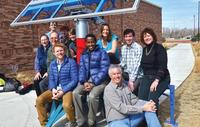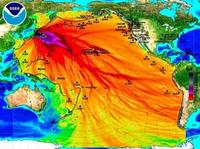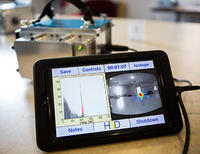-
HHS proposes rules to govern health-care facilities’ disaster preparedness
The Centers for Medicare and Medicaid Services(CMS), a federal agency within the Department of Health and Human Services, has proposed new requirementsfor health-care facilities intended to ensure these facilities are prepared to care for patients during disasters. The regulations aim to prevent the service disruptions which occurred during Hurricane Sandy and Hurricane Katrina, when an estimated 215 deaths occurred in hospitals and nursing homes in Louisiana.
-
-
Antibiotic-resistant bacteria on the rise among U.S. children
Infections caused by a specific type of antibiotic-resistant bacteria are on the rise in U.S. children, according to a new study. While still rare, the bacteria are increasingly found in children of all ages, especially those 1-5 years old, raising concerns about dwindling treatment options. The researchers found that the prevalence is increasing in a resistant type of bacteria, which produces a key enzyme, extended-spectrum beta-lactamase (ESBL), which thwarts many strong antibiotics, making them ineffective.
-
-
Heat waves threaten global food supply

A new study has, for the first time, estimated the global effects of rising temperatures and elevated levels of carbon dioxide (CO2) on the production of maize, wheat, and soybean. Earlier studies have found that climate change is projected to reduce maize yields globally by the end of the century under a “business as usual” scenario for future emissions of greenhouse gases; however, this new study shows that the inclusion of the effects of heat waves, which have not been accounted for in previous modelling calculations, could double the losses of the crop.
-
-
Microbial detection array detects plague in ancient human remains
Scientists who study past pandemics, such as the fourteenth century Black Death, which killed an estimated 30 to 50 percent of the European population from 1347 to 1351, might soon be turning to an innovative biological detection technology for some extra help.
-
-
International food trade can alleviate water scarcity

International trade of food crops led to freshwater savings worth $2.4 billion in 2005 and had a major impact on local water stress, a new study finds. Trading food involves the trade of virtually embedded water used for production, and the amount of that water depends heavily on the climatic conditions in the production region: It takes, for instance, 2,700 liters of water to produce one kilo of cereals in Morocco, while the same kilo produced in Germany uses up only 520 liters. The researchers found that it is not the amount of water used that counts most, but the origin of the water.
-
-
Killing superbugs dead with “molecular drill bits”
Tuberculosis (TB) is a well-known, treatable disease, but resistant strains are cropping up. The World Health Organization (WHO) estimates that about 170,000 people died from multidrug-resistant TB in 2012. In response to drug-resistant “superbugs” that send millions of people to hospitals around the world, scientists are building tiny “molecular drill bits” which kill bacteria by bursting through their protective cell walls.
-
-
Climate change will reduce crop yields sooner than earlier thought
A new study shows that global warming of only 2°C will be detrimental to crops in temperate and tropical regions, with reduced yields from the 2030s onward. In the study, the researchers created a new data set by combining and comparing results from 1,700 published assessments of the response that climate change will have on the yields of rice, maize, and wheat.
-
-
Synthetic biology makes bioweapons easier to make
Scientists and policy makers are no longer unconditionally promoting scientific innovation for fear that current and future biological breakthroughs may lead to dangerous applications. Traditionally, government-backed institutions and pharmaceutical firms fueled biological innovation, but today, the barriers that limited innovation to those institutions are diminishing. The low cost and significantly reduced level of necessary expertise have provided anyone interested in developing biological technology the tools to do so. Synthetic biology, the design and engineering of biological devices and systems, has given terrorists the capability to launch attacks using synthetic organisms without detection.
-
-
Methane from Deepwater Horizon oil spill has entered food web

When millions of gallons of oil spilled into the Gulf of Mexico four years ago, so did large volumes of methane, or natural gas. Now, researchers have confirmed that methane-derived carbon has entered the Gulf’s food web through tiny organic particles floating in the Gulf. The presence of methane is not cause for alarm though, the researchers said. Overall, it has a benign impact on the food that makes it from the sea to people’s dinner tables.
-
-
Innovative solar-powered toilet to be unveiled in India next week

Unsafe methods to capture and treat human waste result in serious health problems and death — food and water tainted with pathogens from fecal matter results in the deaths of roughly 700,000 children each year. A revolutionary toilet fueled by the sun is being developed by University of Colorado Boulder researchers to help some of the 2.5 billion people around the world lacking safe and sustainable sanitation. It will be unveiled in India this month.
-
-
Radiation from Fukushima to reach West Coast in April

On the third anniversary of the Fukushima nuclear plant incident, scientists are reporting that low levels of radiation from the Fukushima plant will reach ocean waters along the U.S. West Coast by April 2014. The scientists say that the radiation will be at levels too low to harm humans, but they call for more monitoring, including at the federal level.
-
-
Innovative nuclear radiation detector reaches the market

A handheld radiation camera developed by University of Michigan engineering researchers offers nuclear plant operators a faster way to find potentially dangerous hot spots and leaky fuel rods. The new Polaris-H detector lays a gamma-ray map over an image of a room, pinpointing radiation sources with unprecedented precision. At least four U.S. nuclear power plants are using versions of the camera, which is now available commercially through the U-M spinoff company H3D.
-
-
Underground recovery process at WIPP begins
Nuclear Waste Partnership (NWP), the management and operations contractor at the Waste Isolation Pilot Plant (WIPP) for the U.S. Department of Energy (DOE), said it has initiated the first phase of an underground recovery process which will lead to the resumption of nuclear waste disposal operations at WIPP. Initial results show no airborne radioactive contamination in the underground shafts.
-
-
Scotland demands U.K. govt. apology over radiation leak at MoD nuke facility
In 2012 the U.K. Ministry of Defense decided to refuel the nuclear reactor on board Britain’s oldest nuclear submarine, HMS Vanguard, after a test reactor operating at the Naval Reactor Test Establishment at Dounreay, Caithness, in Scotland was found to have a small internal leak of radiation. The test reactor had been shut down after the fault was detected, and both the independent Defense Nuclear Safety Regulator and the Scottish Environment Protection Agency (SEPA) had been informed. It now appears that SEPA did not share the information with the Scottish cabinet, or with Alex Salmond, the First Minister of Scotland. Salmond, in a scathing letter to British Prime Minister David Cameron, has demanded an apology from Camron for “disrespecting” the Scottish Parliament and the people of Scotland and for treating both in an “underhanded” manner by not sharing the information about the radiation leaks.
-
-
Determining long-term effects of West Virginia chemical spill
A chemical mixture called crude 4-methylcyclohexane methanol (MCHM) is used during the separation and cleaning of coal products. More than 10,000 gallons of the chemical leaked from a storage tank near Charleston, West Virginia, and entered the river upstream of a water-treatment plant on 9 January. The drinking water of more than 300,000 West Virginians was contaminated. Water restrictions began to be lifted on 13 January, but residents are still detecting the telltale odors of MCHM. Virginia Tech faculty engineers and students are unravelling fundamental chemical and health properties of MCHM.
-
More headlines
The long view
Ransomware Attacks: Death Threats, Endangered Patients and Millions of Dollars in Damages
A ransomware attack on Change Healthcare, a company that processes 15 billion health care transactions annually and deals with 1 in 3 patient records in the United States, is continuing to cause massive disruptions nearly three weeks later. The incident, which started on February 21, has been called the “most significant cyberattack on the U.S. health care system” by the American Hospital Association. It is just the latest example of an increasing trend.
